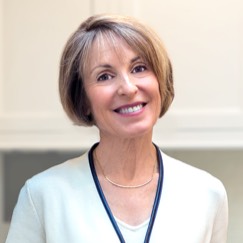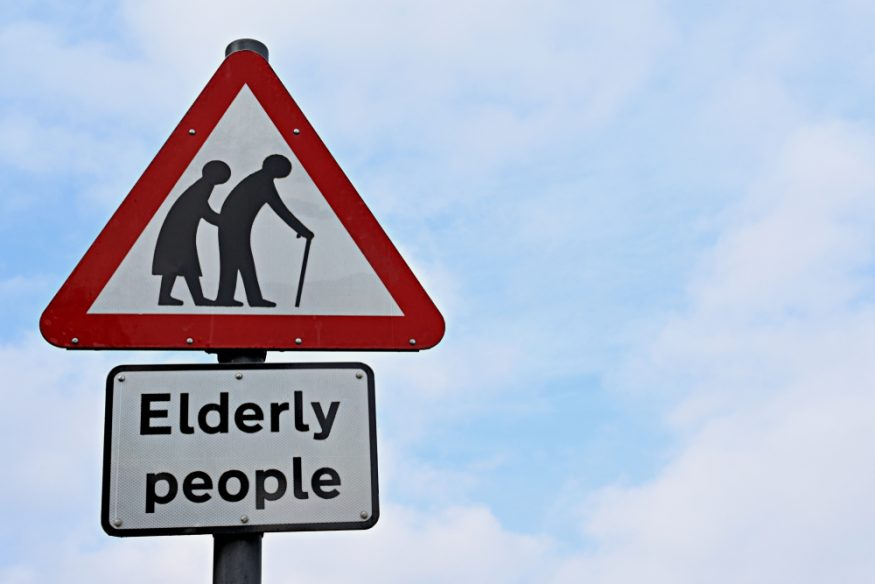By Health & Wellness Editor Kathy Whelan
Being “elderly” doesn’t usually bother me, which is good since I have no control over my chronological age. But some things happened around my birthday this year that got under my (thinning) skin.
First I saw an airport sign saying those age 75 and older need not remove their shoes for TSA screening. Next a stranger addressed me as “dear,” which I’d never been called before (not even by my husband). The check-in form for my annual physical exam asked a slew of questions about whether I need help with daily tasks. All this brought to mind a street sign I’d seen years ago in the UK, showing a stooped-over couple in a crosswalk. Evidently, folks my age are presumed to be feeble.
Each of these annoying things, I should point out, was well-intentioned. And so are attempts by the medical community to show us how to stay healthy and well as we age in an environment filled with unhealthy, highly-processed foods where a sedentary lifestyle is common.
An example is a Mayo Clinic piece outlining what can happen in multiple areas of the body as we age (none of it good) and what we can do about it. Another is Dr. Peter Attia’s bestselling book Outlive, which deals with working on exercise, nutrition, sleep and emotional health to ward off the “chronic diseases of aging.” While these recipes for later-life health are useful and not condescending as I’d felt the airport sign, street sign, questionnaire, and “dear” word to be, they still conveyed, at least to me, a message that the elderly are in for trouble.
Viewing older age as primarily a set of medical issues with outcomes to be avoided is not the only way to see this stage of life, according to Breaking the Age Code by Yale epidemiologist and psychologist Becca Levy, PhD. There is an important social dimension as well.
Dr. Levy has studied the effects of “ageism,” the stereotyping of and discrimination against older adults. She was influenced by an active, spunky grandmother and a graduate fellowship in Japan, where old age is viewed as a stage of life to be enjoyed rather than dreaded. Her work shows that ageism negatively affects physical and cognitive health and wellbeing in many ways and shortens life. Conversely, positive beliefs about aging, like those prevalent in Japan, lead to better health and increased longevity.
Negative beliefs about aging are malleable, according to Dr. Levy, but changing them can be difficult in a society like ours that segregates older people, treats them as burdens, and shows them little respect. We encounter negative age beliefs not only on the individual level but also on the societal level in areas such as healthcare, housing, the workplace, and pop culture. Becoming more aware of them, Dr. Levy writes, is the first step toward changing them.
In one example after another, she shows older adults being active, creative, involved and inspired – adjectives that don’t usually come to mind for this age group. They often live among people of other ages and benefit from intergenerational relationships.
These people who defy age stereotypes perceive themselves as having a future worth investing in. This aligns with what I have learned in my health coaching work: people respond less well to a negative form of motivation than to a positive one. Trying to avoid or get rid of something is much less likely to be successful than trying to achieve or create something. Shaping a lifestyle and beliefs simply to delay or dodge an anticipated decline won’t be nearly as rewarding as working to create a life to look forward to. That is exactly what these older people have done. To them, being “over the hill” is meaningless.
Making our beliefs about aging more positive does not mean we should trade one set of stereotypes for another. While older people may not all be cognitively compromised, slow or helpless, neither are we all energetic, wise or kind. Seeing one another as individuals rather than representatives of a particular age demographic is what I believe we should be aiming for.
Forming more positive age beliefs doesn’t replace the work described in the Mayo Clinic article or Outlive. Instead, as Dr. Attia points out in his epilogue, it makes that work more meaningful. By focusing on what we want in the future – thinking of it as quality time remaining – and striving to make that vision a reality, we may find that some of our very best years lie ahead.
 Kathy Whelan left a successful Wall Street legal career when her doctor warned that her lifestyle of overwork and lack of self-care were not sustainable. She had always been interested in the relationship between lifestyle and health, so eventually Kathy returned to her undergraduate alma mater Duke University to become a certified Integrative Health Coach, with additional training in Mindfulness-Based Stress Reduction. Integrative Health Coaching is based in the neuroscience of behavioral change. Kathy calls it the missing link in addressing individual and national health crises. It’s the foundation of her unique health and wellness coaching for corporate and individual clients. Kathy’s work has been featured in media including The Boston Globe. Learn more at www.whelanwellness.com
Kathy Whelan left a successful Wall Street legal career when her doctor warned that her lifestyle of overwork and lack of self-care were not sustainable. She had always been interested in the relationship between lifestyle and health, so eventually Kathy returned to her undergraduate alma mater Duke University to become a certified Integrative Health Coach, with additional training in Mindfulness-Based Stress Reduction. Integrative Health Coaching is based in the neuroscience of behavioral change. Kathy calls it the missing link in addressing individual and national health crises. It’s the foundation of her unique health and wellness coaching for corporate and individual clients. Kathy’s work has been featured in media including The Boston Globe. Learn more at www.whelanwellness.com


Well said! Aging is natural and begins with our first breath, but ageism is external and we don’t have to accept it.
Absolutely! XO
Thanks, Joan. And you are correct: we don’t have to accept it. As a wise friend of mine says, “ageism seems to be the only socially acceptable ‘ism,’ ” and that needs to change!